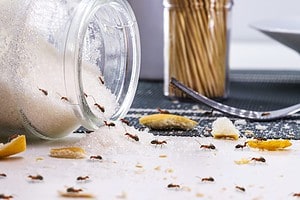Ants are unwelcome house guests. Uninvited, intrusive, and unwilling to leave, these bothersome insects seem to just waltz right into your home. But, they are also pretty simple to eliminate or, even better, to completely avoid.
The two ant species that are most likely to appear during the warmer months are carpenter ants and house ants, also referred to as smelly house ants because of the unique odor they emit when crushed.
Ants come indoors in search of alternative food sources after development, such as building a new home, renovations, or decks, destroys their natural habitat. Although smelly house ants could appear on your countertops or near the shower, they won’t spread disease or actually harm your house.
Carpenter ants, on the other hand, can eat through wet or rotten wood, potentially harming windows, doorways, or even structural frameworks. Carpenter ants have a length of between a quarter to half an inch long.
So, pause before grabbing a can of bug spray and beginning to crop-dust your kitchen counters. We’ve found the best ways to get rid of ants and even prevent them from getting into your home in the first place.
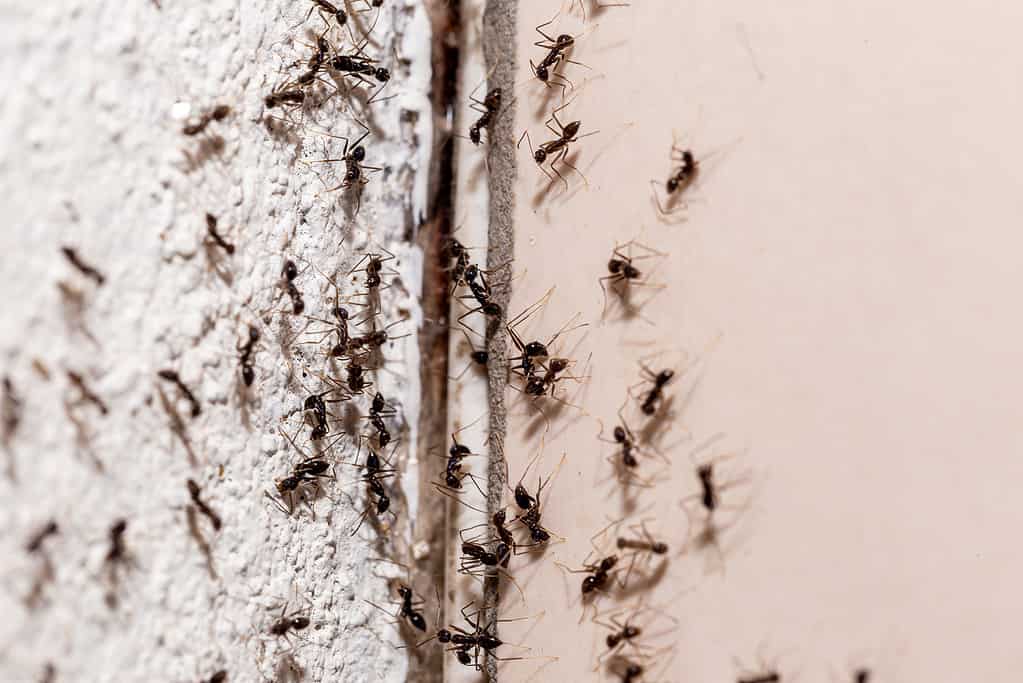
Ants are glad to enter your home if they can find a way in, such as a gap in your weatherstripping or a crack in the basement.
©iStock.com/RHJ
What Attracts Ants to Your Home?
The fact that ants can consume almost anything and live almost everywhere contributes to their abundance. Finding out what draws ants to your property in the first place and causes an ant infestation is crucial if you are interested in getting rid of ants.
Shelter
Although ants are tiny enough to find shelter in almost any place if they can, they prefer to establish a colony from the inside of a warm, comfortable house. Ants are glad to enter your home if they can find a way in, such as a gap in your weatherstripping or a crack in the basement.
Food
Ants consume practically any food made by humans. They will eat any kitchen scraps or crumbs that are left over, but they are particularly drawn to sweets. An abandoned bowl of cereal a drop of syrup, or a bit of pizza crust left on the counter are all great sources of food for ants.
Also, as soon as one ant discovers the source of this delicacy, it will leave a smell trail to draw in the other ants in the colony. In no time, there will be a severe ant infestation.
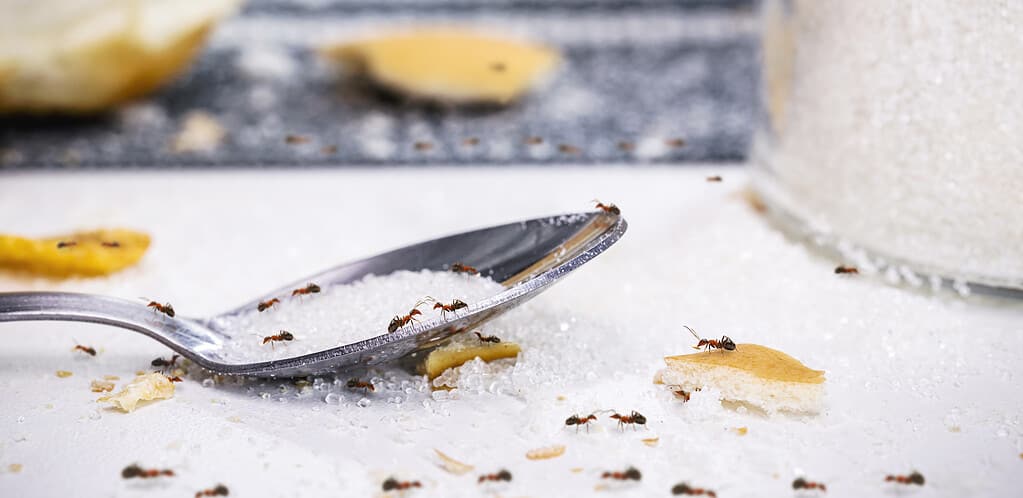
Ants are particularly drawn to sweets and will leave a smell trail to draw in other ants from the colony.
©iStock.com/RHJ
Moisture
For survival, ants require food and water. Yet, unlike other animals, ants can not just drink “as necessary.” They bring water back to their home as well, where it is stored for later use.
To let the remainder of the colony know where a good water source is, they’ll leave a smell trail. As a result, adjacent ants may be attracted by leaky pipes, plant pots, collected dampness in bathrooms, and pet water dishes.
Natural Remedies to Get Rid of Ants
So, you’ve realized you have an ant infestation. What’s your plan of action? Here are a few natural home methods for ant control.
Cleaning Solutions
Ants can be discouraged from entering your home by using household cleaners like hand soap, glass cleaner, or laundry detergent. Keep in mind that ants can’t see well, so they rely on the fragrant pheromone trails they leave behind to find their way around.
Thankfully, common detergent eliminates these traces and deters ants. Wash the surface with warm water and cleaner for optimal results. You may use the same principles for store-bought glass cleaner.
Boric Acid
After three weeks of using boric acid, exposure to it will result in the death of the queen and worker ants in the colony. Prepare a solution with 1/2 teaspoon of boric acid, eight teaspoons of sugar, and one cup of warm water to utilize it efficiently.
As the boric acid dissolves, continue stirring the mixture. Put cotton balls soaked with the mixture wherever you’ve seen ant activity.
Diatomaceous Earth
A form of silica dust known as diatomaceous earth (DE) is created from the crushed, petrified remains of extinct aquatic creatures known as diatoms. DE is not toxic. Instead, it draws oil from their skeletons and dries out pests like ants to kill them.
Merely dust the powder wherever you observe ants coming or passing through your property to kill them with DE.
- 100% ground freshwater diatomaceous earth
- Contains no fillers or additives
- Listed with the Organic Minerals Research Institute
- Powder duster included for easy application
- Made in the USA
- 10% of profits support the local Humane Society
Citrus
D-limonene, an ingredient found in citrus fruits and more specifically in the rinds of oranges and lemons, is poisonous to ants. Save those orange peels and use them to make a DIY ant repellant rather than throwing them away. This is how:
Place used orange peels in a gallon-sized jar. Half of the jar should be filled with peels for maximum performance, and the remaining half should be filled with water. Close the jar and leave it in a dark location for three to five days.
Strain the liquid and then pour the liquid back into the jar, and then stir in a teaspoon of molasses and a tiny bit of dish soap. When you encounter ants, spray the solution directly on them after thoroughly mixing it and putting it in a spray bottle.
The ants will be instantly killed by the citrus oil. Spritz this orange oil extract everywhere you’ve seen ant activity because you can also use it to get rid of ant trails. Plus, it leaves a great scent that will make your home smell freshly cleaned!
Corn Starch
Corn starch, which you most likely already have in your kitchen, is a powerful ant killer. An entire colony of ants can be covered with cornstarch, then water can be dumped on top, or the ants can be covered in cornstarch and vacuumed up.
You will have to remove and discard the dead ants and cornstarch. If you decide to go with option two, be sure to throw away your vacuum canister’s contents right away.
Will Ants Go Away On Their Own?
The short answer here is no, it’s highly unlikely that ants will disappear if left to die out. If ants have already made themselves at home in your residence, it’s because they’ve found conditions that they like and will help them survive.
With consistent effort and a combination of treatments involving both indoor and perimeter insect control, most ant issues can be resolved in about one to two weeks.
If you’ve attempted to maintain cleanliness and secure your food but haven’t seen any progress, it may be necessary to seek professional assistance.
Products for Ant Infestations
These four methods are the most widely used if you want to get rid of ants in the traditional manner. We understand not everyone wants to take the time to try natural methods, so we’ve found some of the best products that people swear by!
Ant Traps and Baits
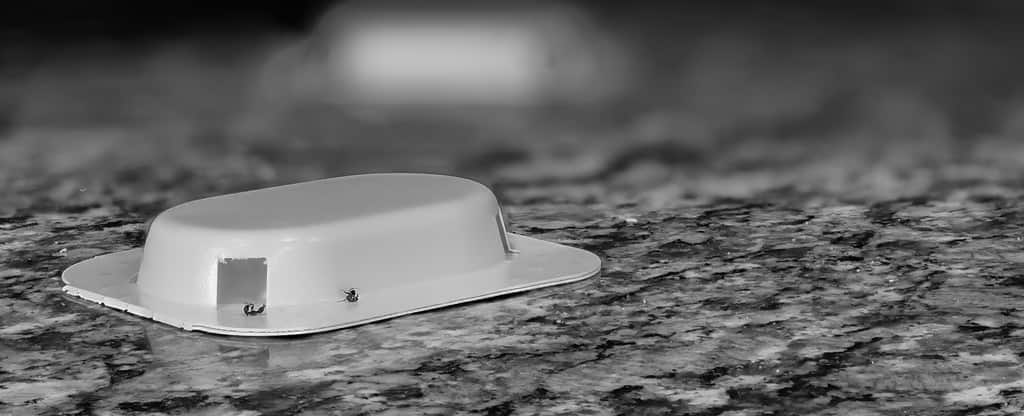
Ant traps also function by luring ants inside and preventing them from escaping.
©iStock.com/Steven White
Similar to baits, ant traps also function by luring ants inside and preventing them from escaping. These traps could potentially be filled with a toxin that quickly kills ants. Regular trap checks are required, and any dead ants must be removed.
This is a great option if you’re looking for something that’s affordable and effective.
Ant baits are tiny, covered pods that you set down in locations where ants have been moving around. The ants discover the pods’ hidden poison and bring it back to their colony. The poison kills the ants in the colony when they eat it.
It’s vital to remember that both children and pets may be in danger from these. It also needs to be checked and replaced on a regular basis.
Ant Spray
After getting rid of the ants in the home, take precautions to prevent their return. Apply an insecticide on doors and windows after caulking and sealing any holes. Only enough water should be sprayed along entry points to cover a four-inch-wide band.
After drying, the spray leaves an imperceptible coating that keeps ants away from the residence. Use the insecticide in the spring to prevent ants. Nevertheless, bear in mind that this simply serves to deter ants from entering; it has the potential to obstruct the usage of ant baits and won’t eliminate ants that are already inside.
Insecticides
There possibly is an ant nest outside of your home if you find ants on the siding in the same spot regularly. Finding siding holes where ants are creeping in and out is the first step in getting rid of ants.
The holes are frequently found under lap siding, in gaps in stucco, or between bricks where mortar has blown out. Treat the area with a bifenthrin-containing insecticide after finding the nest or its proximity.
Granules
Fire ant control is significantly less successful with conventional insecticides. In order to eradicate and destroy ants and other biting insects, you need a specialized product. Make use of a broadcast spreader to apply the granules.
The granules, which fire ants mistake for food but are actually poisonous bait, are carried by them back to their colonies. The ants split the bait before they perish. For up to a year, some of these insecticides continue to kill fire ants. It can take a few weeks before you see all of the results, just like with other baits.
Bonus: Signs of a Carpenter Ant Infestation
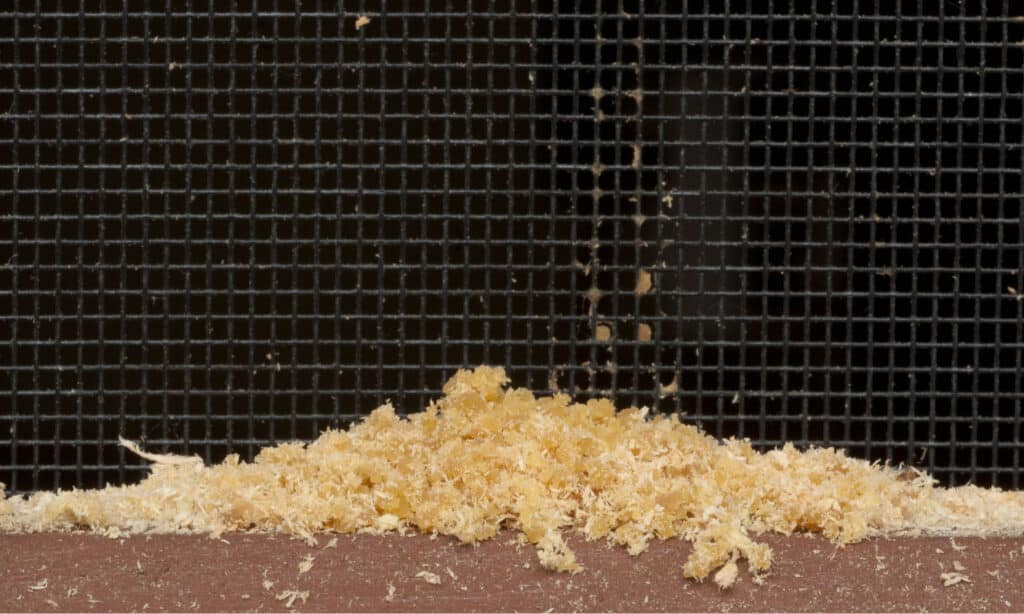
Carpenter ants don’t eat wood – they chew through it to make tunnels and leave the shavings behind.
©Nancy Bauer/Shutterstock.com
Signs of a carpenter ant infestation are often subtle and easy to ignore. You probably won’t see them around much until the problem is already there. Here are some signs that you shouldn’t ignore:
- One ant crawling around inside your home. This is a scout looking for potential food sources. Seeing one or two carpenter ants a week inside probably means your walls are filled with them.
- A dead ant in a spider web. A spider in the basement may have done you a big favor by killing this ant – but it may be a sign that carpenter ants have already moved in.
- Smooth grooves carved out of wood beams. Sometimes carpenter ants accidentally expose their tunnels to the outside world.
- Fine sawdust coming from a crack or piling on the floor. Carpenter ants don’t eat wood – they chew through it to make tunnels and leave the shavings behind.
- Winged ants appear on interior window panes. When a carpenter ant nest releases its young – they sometimes try to get outside through windows. This is a very bad sign.
The photo featured at the top of this post is © iStock.com/DianaLynne
Thank you for reading! Have some feedback for us? Contact the AZ Animals editorial team.







